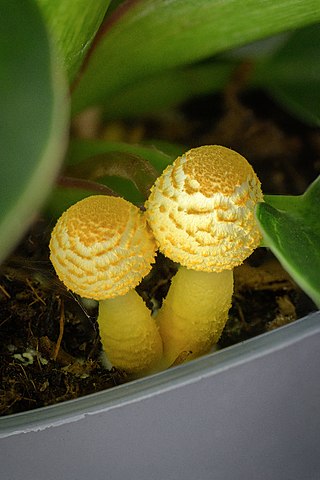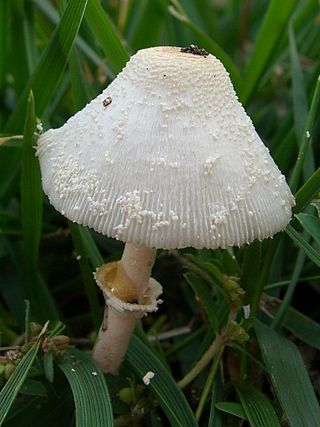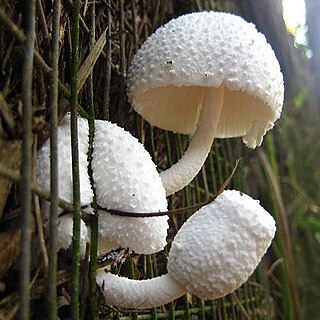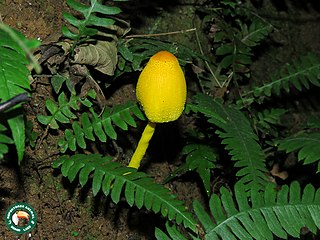
Leucocoprinus birnbaumii, commonly known as the flower pot parasol, yellow parasol, flowerpot parasol, or plantpot dapperling, is a species of gilled mushroom in the family Agaricaceae. It is common in the tropics and subtropics. However, in temperate regions, it frequently occurs in greenhouses and flowerpots, hence its common names of flowerpot parasol and plantpot dapperling. It is considered to be toxic if consumed.
Friedrich Fülleborn was a physician who specialized in tropical medicine and parasitology. He was a native of Kulm, West Prussia, which today is known as Chełmno, Poland.

Leucocoprinus cepistipes, is a species of fungus in the family Agaricaceae. It is also known by the common name onion-stalk parasol in reference to the bulbous stem base. It is typically found on wood debris, such as wood chips but may also grow in potted plants or greenhouses. Typical characteristics include a fine-scaled bell-shaped cap, a partial veil, and a tendency to bruise a yellow to brown when handled.
Epacrophis boulengeri, also known commonly as the Manda flesh-pink blind snake and the Lamu worm snake, is a species of harmless snake in the family Leptotyphlopidae. The species is endemic to Kenya.
Friedrich Thurau (1843–1913) was a German entomologist.

Leucocoprinus cretaceus is a species of mushroom producing fungus in the family Agaricaceae. It is likely tropical in origin although it was first documented in Europe where it was often found growing in greenhouses and bark beds. However many early observations conflate this species with Leucocoprinus birnbaumii or Leucocoprinus cepistipes despite sharing only some superficial similarities. This fungus is quite versatile even for a saprotroph and is often found growing in clusters on woodchips, sawdust and compost heaps as well as directly from the ground or on trees. It may also appear in plant pots and greenhouses in colder countries in which it is not well equipped to survive outside.

Leucocoprinus ianthinus is a species of mushroom producing fungus in the family Agaricaceae. Like several other Leucocoprinus species it may have originated in a tropical climate but now finds a home in plant pots, greenhouses and compost piles in many countries. It is not seen in plant pots with the same kind of regularity as the well known Leucocoprinus birnbaumii and not seen in the wild as frequently as Leucocoprinus brebissonii.
Leucocoprinus straminellus is a species of mushroom producing fungus in the family Agaricaceae. Like other Leucocoprinus species it may have originated in a tropical climate but now finds a home in plant pots, greenhouses and compost piles in many countries. Leucocoprinus straminellus is described as being similar to the more commonly known Leucocoprinus birnbaumii but it is smaller and a lighter shade of yellow with smaller spores that lack a germ pore. It is also described as being superficially similar to Leucocoprinus fragilissimus but slightly more robust with flesh that is less translucent.
Leucocoprinus flavescens is a species of mushroom-producing fungus in the family Agaricaceae.

Leucocoprinus brunneoluteus is a species of mushroom producing fungus in the family Agaricaceae.
Leucocoprinus longistriatus is a species of mushroom producing fungus in the family Agaricaceae.
Leucocoprinus flavus is a species of mushroom producing fungus in the family Agaricaceae.
Leucocoprinus tricolor is a species of mushroom producing fungus in the family Agaricaceae.
Leucocoprinus medioflavus is a species of mushroom producing fungus in the family Agaricaceae.
Leucocoprinus discoideus is a species of mushroom producing fungus in the family Agaricaceae. In the local language when the mushroom cap is open it is known as batakania or bepokua pembe when it is immature with a closed cap. However 'bepokua' may also be used to refer to other similar looking mushroom species such as Micropsalliota bambusicola.
Leucocoprinus austrofragilis is a species of mushroom producing fungus in the family Agaricaceae.
Leucocoprinus velutipes is a species of mushroom producing fungus in the family Agaricaceae.
Leucocoprinus inflatus is a species of mushroom producing fungus in the family Agaricaceae.
Leucocoprinus revolutus is a species of mushroom producing fungus in the family Agaricaceae.
Leucocoprinus canariensis is a species of mushroom producing fungus in the family Agaricaceae.




